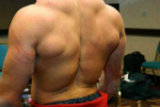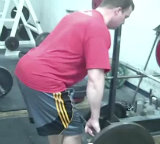28-Days-to-Lean Meal Plan
With the right plan and the right discipline, you can get seriously shredded in just 28 days.
Read article

I actually wrote about this very thing in my article 7 Ways to Crush Your Workout. Check out the picture of this Chinese Olympic weightlifter to the left. Notice anything? His traps are freaking huge! For their sport, they perform a massive volume of shrugging and high pull movements. And as you can see, the results are phenomenal.
For a unique trap-building exercise, I recommend snatch grip shrugs. I would also focus on 8-12 reps per set. As I said in the article mentioned above:
“Barbell shrugs get old after a while, so switch it up. Move your hands out (pointer finger on the outside rings) and perform snatch grip barbell shrugs—trying to touch your shoulders to your ears. Work up and perform them with a decent amount of weight if you want to tear the muscle off the bone. This simple modification is enough to dominate your traps like you haven’t done in a long time. Focus on keeping your chest up and head forward and don’t let your head fall down, as the weight gets heavier or fatigue sets in. I would also recommend using straps because in this wide-grip position, your grip will definitely be a limiting factor.“

First and foremost, I would first get checked out with your doctor and see what he recommends for your training. I would not go against whatever he says and I am not qualified to offer any rehab advice. If you are cleared to train and he states that Romanian Deadlifts are okay, then read on. Romanian Deadlifts, or RDLs, are primarily a hip hinge movement.
Think of RDLs as the top half of a deadlift. They are performed by first moving the hips backward, with your knees slightly bent, and only allowing the bar to move down to right below your knees. One critical tip is to keep the bar as close to your body as possible, by actively pulling it into your legs the whole time. If the bar floats away, this creates a ton of shear forces on your lower back.
To answer your question, to minimize stress on the neck when performing RDLs, keep your neck in a neutral position the entire time. What that means is that you don’t want to look up (hyperextension) as your hips move back. Keep your head in the same line as your torso. Imagine placing a dowel rod on your back and the rod will keep contact with the back of your head, between your shoulder blades and your tailbone—the entire time. If you look up, the dowel rod would come off your back losing one of the three contact points.
How to Perform RDLs
Important Tip for RDLs

Meet the Lift Doctor
Jim Smith is a highly respected, world-renowned strength and conditioning coach. A member of the LIVESTRONG.com Fitness Advisory Board, Jim has been called one of the most "innovative strength coaches" in the fitness industry. Training athletes, fitness enthusiasts and weekend warriors, Jim has dedicated himself to helping them reach "beyond their potential." He is also the owner of Diesel Strength & Conditioning in Elmira, NY.